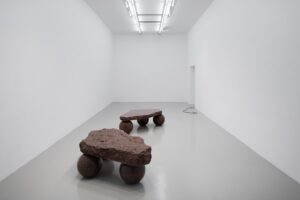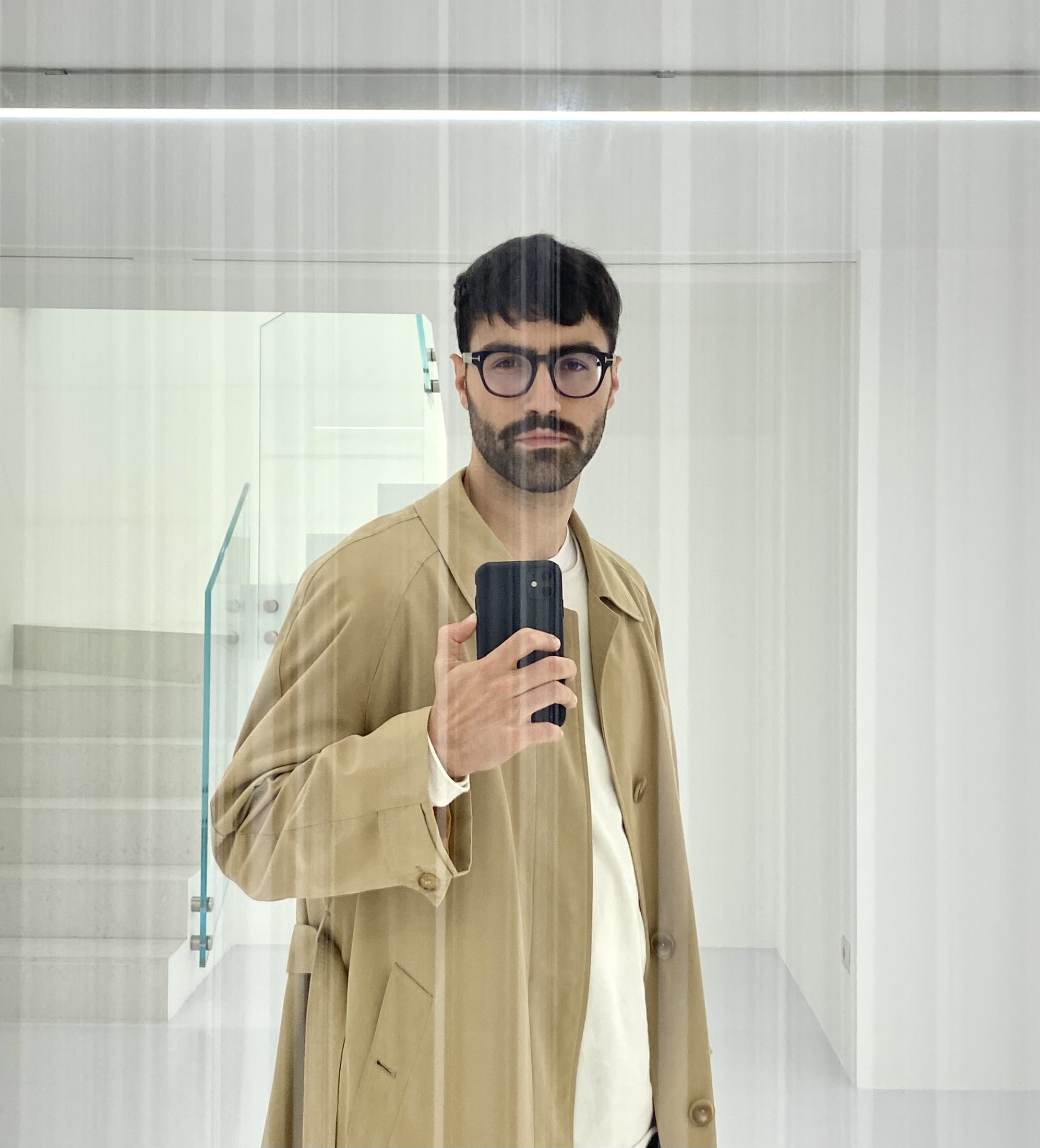Conveyed from the realm of boxing, the aphorism “gettare la spugna” (“throwing in the towel” – translated in Italy as sponge instead of towel) is used in Italian to symbolize surrender, the act of giving up and admitting defeat, suggesting a feeling of resignation on the part of the person making it. This expression, used as the title of Mario Garcia Torres’ latest exhibition at Galleria Massimo Minini, does not merely suggest taking a step back or sideways from the work created; rather, it aims to unveil a rejection of the conventional conception of artwork, an interruption, and almost an abandonment of one’s own role and even self-definition, leaving open doors for various reinterpretations.

Mario Garcia Torres, “Gettare La Spugna”, installation view, photo Petro Gilberti, courtesy Galleria Massimo Minini, Brescia
Mario Garcia Torres plays on the definition of the artwork from the very beginning. Walking into the gallery spaces, the Mexican artist immediately places us in relation with two ambiguous objects, which could simultaneously be “coffee tables” and sculptures, Pastiche Table and Brutalist Sculpture, both made of granite. Depending on the narration and the use made of them, they can become functional objects or genuine artworks. The assumption of the essence of artwork for any object displayed in a gallery is not enough to define it as such according to the artist, who therefore makes confusion, or rather, the suspension of definition, the protagonist. Plunged into a state of indecision, the viewer is then guided through the exhibition, and after passing the two granite blocks, is invited to follow the movement of a water pipe, which is no longer, as one might suspect, an actual water pipe but a bronze sculpture that emulates the lightness of movement of a tube snaking through space, yet is actually rigid and fixed.

Mario Garcia Torres, “Gettare la spugna”, installation view, photo Petro Gilberti, courtesy Galleria Massimo Minini, Brescia
This is the work This is an object I Made While Thinking of Alighiero Boetti, in which Mario Garcia Torres imposes an extraordinary narrative starting from a simple “What if”. The artist indeed wonders what the continuation of the famous self-portrait Mi fuma il cervello (My Brain Smokes) created in 1993-94 by Boetti (to whom the first encounter between Massimo Minini and Mario Garcia Torres is owed) could have been, and builds on this subtle line of possibilities a narrative that imposes itself on the object, and consequently on us. In this sense, we approach cinema. Artwork is imbued with a narrative that doesn’t engulf us in the object but rather penetrates within us.

Mario Garcia Torres, “Gettare la spugna”, installation view, photo Petro Gilberti, courtesy Galleria Massimo Minini, Brescia
This reinterpretation of the artwork makes us reflect on the importance of narration. The artist relinquishes his protagonism in some way to place the story and influences on the viewer at the center stage. Mario Garcia Torres works by investigating the definition of the artist and his methods of creating artwork, questioning the concept of authority to confront the viewer with the mystery and signs of his passage. Fugitive, he doesn’t define himself. He doesn’t tell his own story in first person bored of the definition of himself but lets others do it (as it is indeed happening at this exact moment). The artist’s bio is directly provided to us by the work What I Would Say If I Were Mario Garcia Torres (Chiara), in which he quotes Christopher Wool in the iconic fictitious interview for the Whitewall magazine where Richard Hell spoke for him.

Mario Garcia Torres, “Gettare la spugna”, installation view, photo Petro Gilberti, courtesy Galleria Massimo Minini, Brescia
The sense of mystery that arises envelops even the last two rooms of the exhibition, where two more taps are placed facing each other with bronze water pipes wound around them. These are Stored Celebration and A Pause, sculptures that continue the narrative trail linking with Boetti. However, alongside these two works, there are five acrylics on canvas presenting captions – sometimes complete, sometimes incomplete – of some works on paper missing from the catalog of the Californian artist Ed Ruscha. Mario Garcia Torres here brings out another aspect of reflection on the essence of artwork. By exploiting the theme of works missing from cataloging, the artist once again constructs a narrative that allows for the restitution in reality of new works structured on the possible link between past and present, materializing in these canvases cataloging absent works, not yet traced or that have not left a trace of economic transactions, therefore nonexistent to the system. In this particular case, the reflection also revolves around the world of transactions that regulate the art market, thus on another aspect of definition given to the work.

Mario Garcia Torres, “Gettare la spugna”, installation view, photo Petro Gilberti, courtesy Galleria Massimo Minini, Brescia
This continuous oscillation of definitions, sprung from Mario Garcia Torres’ narratives, leaves one bewildered facing the artist’s last installation, Gettare la spugna (Throwing in the towel), with which the circle of reflection is closed. Randomly arranged on the ground, the viewer is confronted with thirtyseven sponges (also in bronze) that depict in a sort of freeze frame the moment following the act of surrender in which the artist must have thrown these pieces. Obviously, this parable turns out to be fictitious as well, but the game in which Mario Garcia Torres transports us is worth it because in this last narration – starting from the aphorism “throwing in the towel” – the abandonment of the artist’s role and the suspension of the act are materialized in the gesture and reflected in the viewer invited to the confrontation.
Info:
Mario Garcia Torres. Gettare la spugna
24.02 – 08.05.2024
Galleria Massimo Minini
Via Luigi Apollonio, 68 Brescia
www.galleriaminini.it

Matteo Giovanelli (Brescia, 1999) is an art historian. He holds a Bachelor’s degree in Cultural Heritage from the University of Verona where he pursued a Master’s degree in Arts. With a background rich in academic study and practical experience he collaborates with contemporary art galleries, navigating various curatorial environments, from galleries exhibitions to museums and fairs.






NO COMMENT